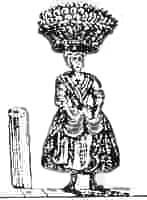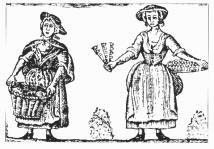
Potato seller, late 18th century
Royal Society of Antiquaries of Ireland

Women street vendors, late 18th century
Royal Society of Antiquaries of Ireland
Research on Dublin in the early modern period has shown that most trades were dominated by men and that people tended to marry into families with similar trades. Children gradually learned by helping their elders from an early age and they might enter on a formal apprenticeship later on.
Widows often carried on the family business,
| Thus a number of women, more usually widows, were to be found [in Dublin in the eighteenth century] in such occupations as butchers, plumbers, furriers, skinners, goldsmiths - trades that gradually became more male-dominated. Imelda Brophy, 'Women in the workforce' in The gorgeous mask, Dublin, 1987, p.53. |
|
Overall, the evidence suggests that, in the second half of the eighteenth century, female merchants and traders formed a permanent feature of the commercial life of Temple Bar. Though the numbers were not large, their involvement increased steadily from 3.7 per cent in 1752 to just under 9 per cent in 1800. The statistics also suggest a positive correlation between the proportion of women involved and the economic environment at the time. As individual businesses thrived, females in these industrial households became more permamently involved in the ongoing work. |
In addition, unknown numbers of women worked full-time or part-time in a variety of occupations such as dealing in old clothes and shoes, sorting feathers, informal nursing, wet nursing, domestic service, cooking, cleaning and washing clothes.
Women dominated the clothing trade as well as millinery (hat making).
|
'Clothing trade' included seamstresses, dressmakers, milliners, lace makers, tassel makers, staymakers and bonnet makers. |
Men earned more than women and they often combined together in the male interest, one of which was to edge women out of trades. At an investigation into Irish trade combinations in 1782,
| ... one Dublin worsted manufacturer pointed out that combinations in that trade in the 1760s and after had caused all the city women to lose their jobs for no reason other than the fact that male journeymen felt 'the women had not a right to work at men's work, it was their inheritance.' The fact that the manufacturer in question felt that 'the women did most parts of the weaving better than the men, more diligently and cleaner' may have been a reason for the male employees' discontent. Imelda Brophy, 'Women in the workforce' in The gorgeous mask, Dublin, 1987, p. 58. |
A study of 662 widows out of a population of nearly 11,000 in Carrick-on-Suir in 1799 suggested that most widows would have inherited little from their husbands. They probably worked for their offspring or were dependent on them, as 80 per cent had no stated occupation in 1799. Their prospects of remarriage were slim since there was a surplus of women in the town and four times as many widowers as widows. The study gives some idea of the range of paid work done by the women who did have employment in an industrialised town at the time.
| Apart from those widows employed in the woollen industry, they most commonly worked as charwomen, washerwomen and petty traders such as pedlars, hawkers and hucksters. We occasionally find a more substantial trader such as Mrs Russell or her next door neighbour, Mary Green, a tobacconist. The food and drink sellers - corn and meal dealers, bread women, beer sellers, lodging house-keepers, etc. - were in a small way of business, except possibly for Mrs Ellen Quirk, a publican who had a clerk and a servant to help her. Widows working in the clothing trades included dress-makers, seamstresses and mantua makers. L.A. Clarkson & E.M. Crawford, 'Life after death: widows in Carrick-on-Suir, 1799' in Margaret MacCurtain & Mary O'Dowd, Women in early modern Ireland, Dublin, 1991, p.249. |
|
Potato seller, late 18th century |
Women street vendors, late 18th century |